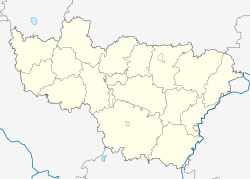Yuryev-Polsky (town)
| Yuryev-Polsky (English) Юрьев-Польский (Russian) |
|
|---|---|
| - Town - | |
 View of Yuryev-Polsky |
|
 Location of Vladimir Oblast in Russia |
|
|
|
|
|
|
|
|
|
|
| Administrative status (as of September 2013) | |
| Country | Russia |
| Federal subject | Vladimir Oblast |
| Administrative district | Yuryev-Polsky District |
| Administrative center of | Yuryev-Polsky District |
| Municipal status (as of June 2012) | |
| Municipal district | Yuryev-Polsky Municipal District |
| Urban settlement | Yuryev-Polsky Urban Settlement |
| Administrative center of | Yuryev-Polsky Municipal District, Yuryev-Polsky Urban Settlement |
| Statistics | |
| Population (2010 Census) | 19,595 inhabitants |
| Time zone | MSK (UTC+03:00) |
| Founded | 1152 |
| Postal code(s) | 601800 |
| Dialing code(s) | +7 49246 |
| on | |
Yuryev-Polsky (Russian: Ю́рьев-По́льский) is an old town and the administrative center of Yuryev-Polsky District of Vladimir Oblast, Russia, located in the upper reaches of the Koloksha River, 68 kilometers (42 mi) northwest of Vladimir, the administrative center of the oblast. Population: 19,595 (2010 Census);19,906 (2002 Census);22,247 (1989 Census); 23,000 (1974).
It was founded by Yury Dolgoruky in 1152. First part of its name derives from Yury's patron saint, St. George. The second part is derived from the word polsky meaning "in the fields". This specification was needed in order to distinguish the town from the earlier established fortress of Yuryev (nowadays Tartu), at the time located in the woods in what is now Estonia and then the biggest Russian settlement in the territory of the Chuds.
Upon Vsevolod III's death in 1212, the town was assigned to one of his youngest sons, Svyatoslav. It was that prince who personally designed the town's chief landmark, the Cathedral of St. George (1230–1234). It is the latest pre-Mongol construction in Russia, unprecedented in abundance of stone sculptures, and also the model for first stone churches in the Moscow Kremlin. In the 1460s, the cathedral's dome collapsed, thus burying most of unique sculptures which had adorned the cathedral walls. The collapsed roof was sloppily restored by a well-known Muscovite artisan, Vasili Yermolin, in 1471.
...
Wikipedia


